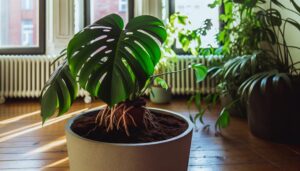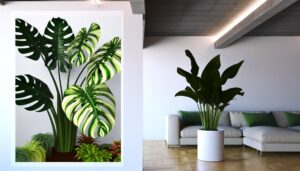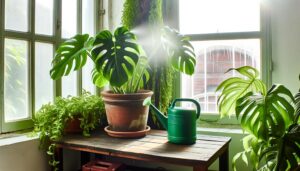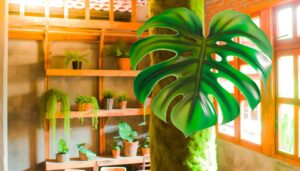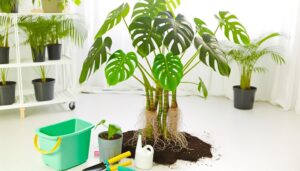Monstera Adansonii Vs Rhaphidophora Tetrasperma
Monstera Adansonii and Rhaphidophora Tetrasperma are both in the Araceae family but different genera. Monstera Adansonii has lacy, heart-shaped leaves with oval fenestrations, while Rhaphidophora Tetrasperma features smaller, deeply lobed leaves with a leathery texture.
Both plants prefer bright, indirect light, and high humidity around 60%. Monstera Adansonii grows vigorously with robust aerial roots, contrasted by the more compact, rapid growth of Rhaphidophora Tetrasperma.
Watch for pests like spider mites and avoid overwatering to prevent root rot. Dive deeper to understand the nuances and specific care needs of these fascinating plants.
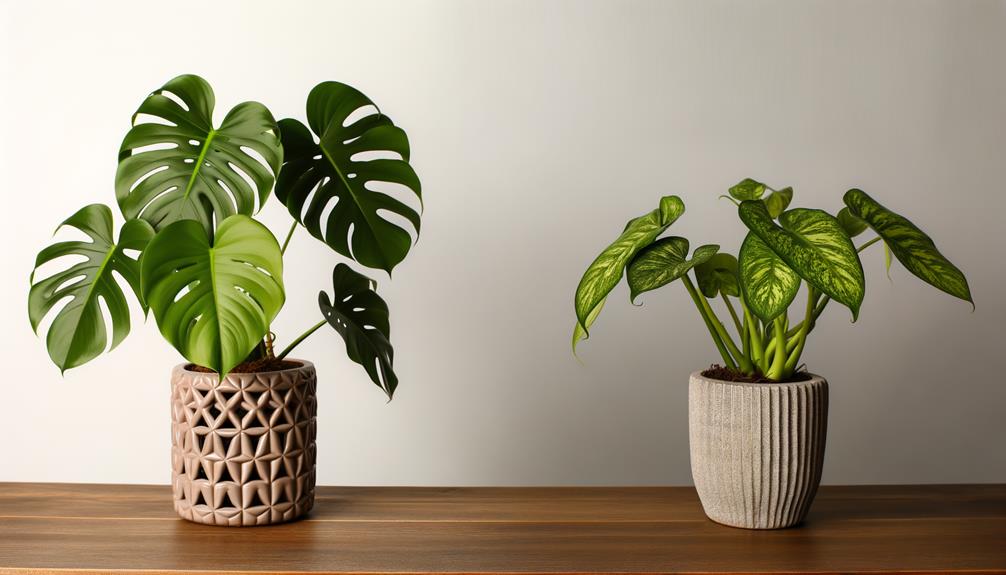
Key Takeaways
- Monstera adansonii has heart-shaped leaves with oval fenestrations, unlike Rhaphidophora tetrasperma's smaller, deeply lobed leaves.
- Monstera adansonii leaves form a lace-like appearance, while Rhaphidophora tetrasperma leaves are compact and leathery.
- Both plants thrive in bright, indirect light and need well-draining soil, with similar humidity and temperature requirements.
- Monstera adansonii exhibits vigorous growth with extensive fenestration, whereas Rhaphidophora tetrasperma has a compact growth form with shorter internodes.
- Common issues include leaf yellowing, pests like spider mites, and root rot; both plants need high humidity for optimal health.
Botanical Classification
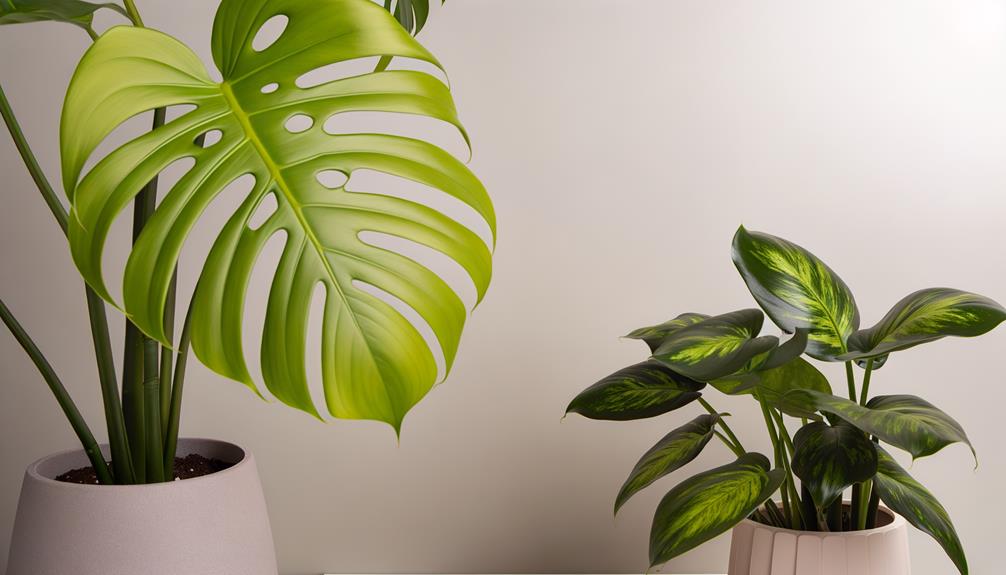
In botanical classification, Monstera adansonii belongs to the Araceae family, while Rhaphidophora tetrasperma is classified under the same Araceae family but within a different genus.
You'll find that the Monstera adansonii is part of the Monstera genus, characterized by its fenestrated leaves. In contrast, Rhaphidophora tetrasperma falls under the Rhaphidophora genus, known for its rapid growth and distinct leaf morphology.
Despite sharing the Araceae family, these plants diverge in their genera, leading to differences in their botanical traits and growth patterns. Understanding these classifications helps you appreciate the nuances in their care requirements, natural habitats, and evolutionary adaptations, making your horticultural endeavors both informed and successful.
Visual Differences
When comparing Monstera adansonii to Rhaphidophora tetrasperma, you'll notice significant differences in leaf structure and morphology that are essential for proper identification. Monstera adansonii features elongated, heart-shaped leaves with multiple oval fenestrations, or holes, which create a lace-like appearance. The leaf margins are smooth, and the overall texture is thinner and more delicate.
In contrast, Rhaphidophora tetrasperma displays smaller, deeply lobed leaves with fewer fenestrations. These leaves are more compact and have a thicker, leathery texture. Additionally, Rhaphidophora tetrasperma's lobes extend almost to the central vein, creating a more divided appearance.
Care Requirements
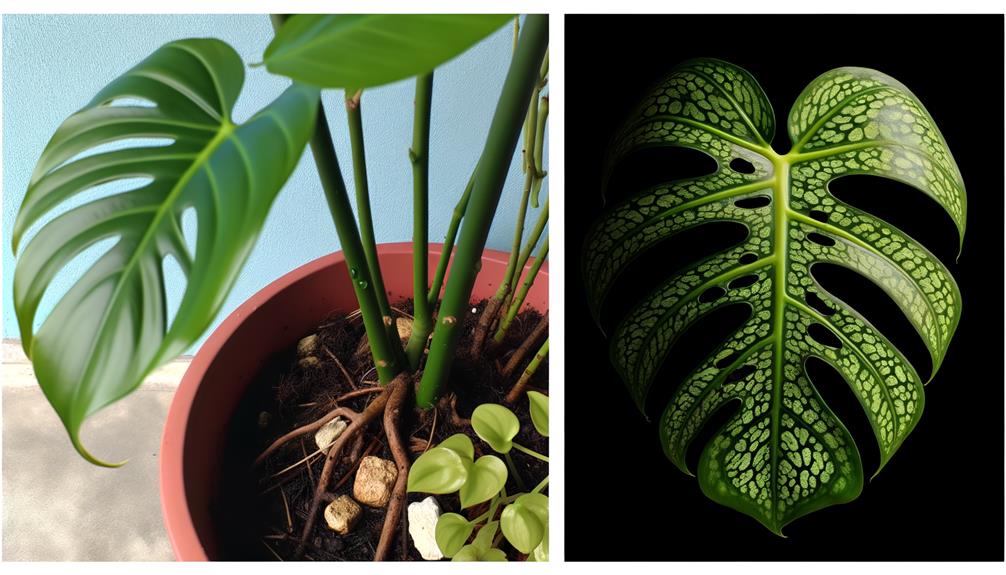
Proper care for Monstera adansonii and Rhaphidophora tetrasperma involves understanding their specific light, water, and humidity needs to guarantee optimal growth and health. Both thrive under bright, indirect light but can tolerate lower light conditions. Overwatering is a risk; let the top inch of soil dry before watering.
Follow these guidelines to keep your plants happy:
- Light: Place them in bright, filtered sunlight. Avoid direct sunlight as it can scorch the leaves.
- Water: Water thoroughly but infrequently. Ensure the soil is well-draining.
- Humidity: Maintain humidity levels around 60% to simulate their tropical origins.
- Temperature: Keep the ambient temperature between 65°F and 80°F (18°C to 27°C).
These precise care measures will help your plants thrive.
Growth Patterns
Understanding their growth patterns is important for managing Monstera adansonii and Rhaphidophora tetrasperma. Both plants exhibit unique vining habits and aerial root development that influence their support needs and overall structure.
Monstera adansonii tends to grow more vigorously with longer internodes and extensive fenestration in its leaves. It develops robust aerial roots that latch onto trellises or moss poles, enabling vertical growth.
Rhaphidophora tetrasperma, often mistaken for a mini Monstera, has a compact growth form with shorter internodes and fewer, but more pronounced, leaf splits. It also produces aerial roots but requires less structural support.
Common Issues
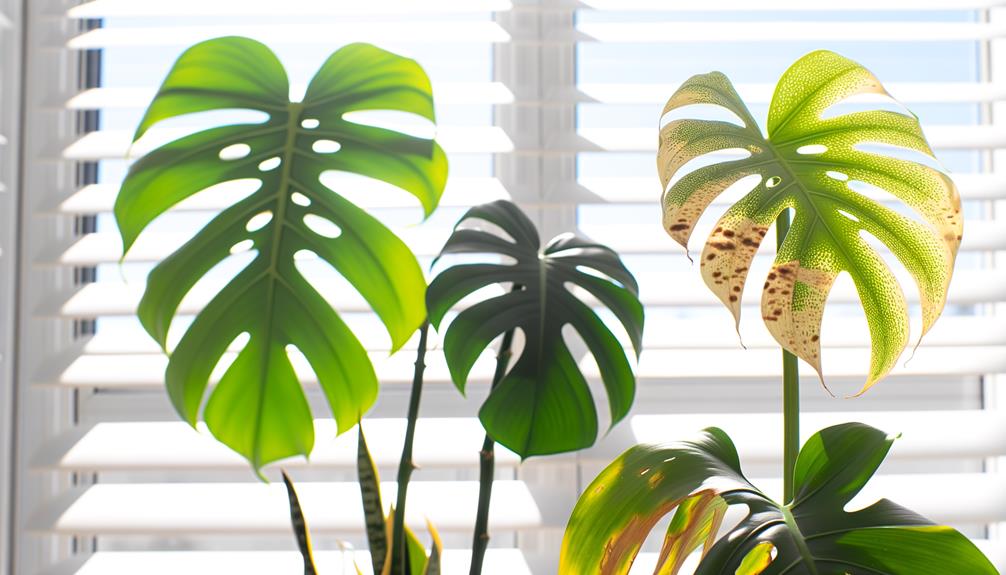
Both Monstera adansonii and Rhaphidophora tetrasperma are prone to common issues like leaf yellowing, pest infestations, and root rot, which can greatly impact their well-being if not promptly addressed.
To manage these problems effectively, you should:
- Leaf Yellowing: Often due to overwatering or nutrient deficiencies. Guarantee well-draining soil and balanced fertilization.
- Pest Infestations: Common pests include spider mites and mealybugs. Regularly inspect leaves and use insecticidal soap if needed.
- Root Rot: Caused by poor drainage or overwatering. Utilize pots with drainage holes and avoid waterlogged soil.
- Inadequate Humidity: Both species thrive in high humidity. Use a humidifier or pebble tray to maintain ideal moisture levels.
Proactively addressing these issues guarantees your plants remain vibrant and healthy.
Conclusion
In comparing Monstera adansonii and Rhaphidophora tetrasperma, remember: each plant's unique beauty and care needs define their charm.
With Monstera's perforated leaves and Rhaphidophora's mini-monstera look, your choice hinges on personal preference.
Understand the nuances of their growth patterns and care requirements to guarantee lush, thriving greenery.
Ultimately, these botanical wonders, like two sides of the same coin, offer distinct yet complementary aesthetics for any plant enthusiast. Choose wisely, and your garden will flourish.

